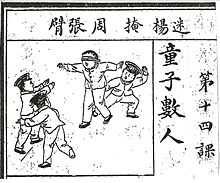Blind man's buff
Blind man's buff or blind man's bluff is a children's game, a variant of tag in which the player who is "It" is blindfolded. The traditional name of the game is "blind man's buff", wherein the word buff is used in its older sense of a small push. The game later also became known as "blind man's bluff"; it is possible that this name is a linguistic corruption.
Versions

There are several versions of the game:
- In one version, the first player tagged by It then becomes It, and another round of the game is played. The Chinese version refers to the tagged It as lìng dài 令代, literally "to bid to take the place of".
- In another version, whenever any player is tagged by It, that player is out of the game. The game proceeds until all players are out of the game, at which point another round of the game starts, with either the first player or the last player to be tagged becoming the next It player.
- In yet another version, It feels the face of the person tagged and attempts to identify the person, and only if the person is correctly identified does the person become It.
- In a unique Japanese version, young girls dress up in their kimonos and the blind-folded girl must catch or touch the other girls both while blindfolded and at the same time carrying a full cup of tea. This is portrayed in Shuntei Miyagawa's woodblock print Kodomo-no-Asobi (Children at Play), published in 1899 by Matsuki Heikichi of Tokyo.
History
A version of the game was played in Ancient Greece where it was called "copper mosquito."[1][2] In China versions of the game claim lineage as far back as the late Zhou Dynasty (circa 500 B.C.) and the Han Dynasty.[3] The game is played by children in Bangladesh known as Kanamaachhi [কানামাছি] meaning blind fly. One individual is blind-folded in order to catch or touch one of the others who run around repeating, “The blind flies are hovering fast! Catch whichever you can!” The game has been known to be played since during the Tudor period, as there are references to its recreation by Henry VIII's courtiers. It was also a popular parlor game in the Victorian era. The poet Robert Herrick mentions it, along with sundry related pastimes, in his poem "A New Yeares Gift Sent to Sir Simeon Steward":[4]
That tells of Winters Tales and Mirth,
That Milk-Maids make about the hearth,
Of Christmas sports, the Wassell-boule,
That tost up, after Fox-i' th' hole:
Of Blind-man-buffe, and of the care
That young men have to shooe the Mare
It is also played in many areas in Asia including Afghanistan and all over Europe including Germany.
Similar games
A children's game similar to blind man's buff is Marco Polo. Marco Polo is played in a swimming pool; the player who is "it" shuts their eyes and calls out "Marco" to which the other players must reply "Polo", thus indicating their positions and making it easier for "it" to go in the right direction.
Another children's game similar to blind man's buff is Dead Man. Dead Man is played in an open place. One player is "it" and has to close his/her eyes. Then the other people say "Deadman/Deadgirl, come alive, come alive at the count of five. One, two, three, four, five." Then the "Deadman/Deadgirl" has to walk around with their eyes closed trying to tag people.
See also
References
| Wikimedia Commons has media related to Blind man's buff. |
- ↑ A Greek-English Lexicon. Oxford: Oxford University Press 1889. p. 1151.
- ↑ “blindman’s buff,” Encyclopædia Britannica. 15th edition. 2. Chicago: Encyclopædia Britannica, Inc. 2010. p. 283.
- ↑ 中華初等小學國文教科書 Missing or empty
|title=(help) - ↑ Richards, Grant (1902). The Poems of Robert Herrick. London, Leicester Square. pp. 123–4.